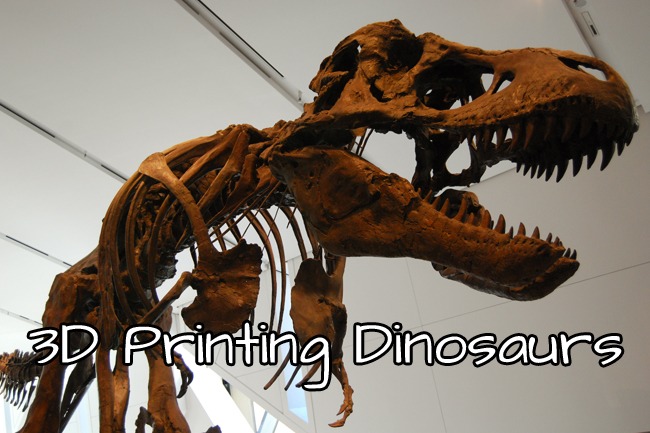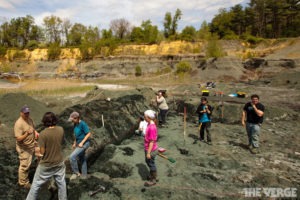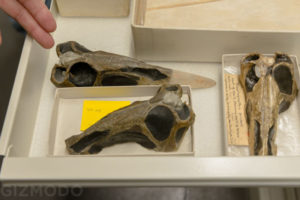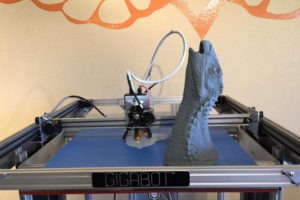
With Jurassic World premiering in just three weeks, talk of dinosaurs has been all of the Internet. I can’t tell you how many times I’ve read speculation articles or watched new trailers moments after their release.
An added bonus is that it comes out on my birthday—a nice little present for me from the kind folks at Universal.
But in all of this excitement for genetically modified dinosaurs, I think their real-life fossilized counterparts are feeling a little left out. Why can’t actual dinosaurs get some love too?
Sometimes, there are problems with using fossils
I think some of the issue lies in the fact that a lot of the current dinosaur skeletons aren’t complete. The complete information is extrapolated from just a few real bones (35 in the case of the Hadrosaurus), so displays aren’t always impressive. The missing bones are often filled in with plaster approximations, but this can get pretty expensive for the museums.
There can be irreversible damage
Another problem is that mounting real fossils causes irreversible damage to the bones. The mounting hardware must be anchored directly into the bones, which is obviously problematic for preservation. Mounting the bones causes another problem, too, because it puts the bones in a difficult to reach place if scientists want to research them some more. And if scientists realize that the skeleton is put together incorrectly, repositioning the bones can cause even more damage.

Waiting on fossils takes a long time
If museums have to wait for scientists to finish studying the bones, then the public has to wait too. That means the information available to us regular people is old—and at least not the most up to date. Fossils, like this T rex, can be tied up for years before making it out to the eyes of the curious—and what better way to inspire adoration for dinosaurs than with “fresh” bones in new exhibits?
Fossils just can’t show how impressive these dinosaurs were
One final hindrance is that skeletons aren’t whole dinosaurs. Even if all fossils contained all the bones required for a whole dinosaur, we still wouldn’t have muscles or skin to really understand the massiveness of most dinos. Sure, sometimes you can see model dinosaurs in museums, maybe even animatronic ones, but those are expensive too.
Thankfully, 3D printing can help
Fortunately, 3D printing can help with all of these problems. This technology is rapidly improving while growing cheaper, and it has vast possibilities for improving museum displays and sparking scientific curiosity in the lucky kids who get to visit science museums.

Instead of using plaster models to complete dinosaur skeletons, scientists can create 3D printed plastic bones. They can scan similar bones and create realistic models without spending a lot of time or money. These plastic bones can be made hollow, which plaster bones can’t be, which makes them lighter and easier to mount.
So even though the skeletons still aren’t complete, 3D printing makes it easier and cheaper to complete them in a more accurate way.
Plastic bones are lighter and more durable
Because these plastic bones are lighter and easier to mount, museum can basically do whatever they want with them. They’re not as fragile as plaster bones and definitely not as fragile as the real fossils, so they’re much safer to handle. And if a scientist realizes something with the bones is wrong, it’s much easier to replace, remove, or reposition the plastic replicas.
Plastic bones can be displayed much more quickly
When fossils are first discovered, they can’t be put on display in a museum right away—they have to be studied first. But scanning newly discovered fossils takes a very short amount of time and can be done immediately even in the field, as was the case at Cerro Ballena in Chile. When construction workers uncovered fossilized whale bones, the Smithsonian Institution went and scanned all of the bones before they were relocated to Chilean museums.
Now, the Smithsonian has 3D models of the bones that they can print and display in their museum, but they also have the ability to continue studying the bones even without access to the originals. Chile gets to keep and display its fossils, research at the Smithsonian can continue, and visitors still get to see and learn about the new discovery.

Scientists can print entire dinosaurs!
Another amazing thing you can do with 3D printing is print life-size dinosaur statues. Deep in the Heart Art Foundry in Texas is working with the Australian Age of Dinosaurs museum to create 3D printed dinosaurs to scale. Although they’re not making huge T-rexes yet, the twelve finished statues will be between three and eighteen feet long. After the 3D printing is complete and the statues are assembled, they’ll be cast in bronze and displayed in the museum.
Museums could also do a similar thing to sell little models of fossils in their gift shops. A visitor wants one particular fossil? It can be ordered right there and be ready when the visitor leaves!
3D scanning and printing technology is growing fast
But what technologies are necessary for 3D printing dinosaurs to make sense? Obviously 3D printers that can handle the level of detail necessary for the dinosaurs and dinosaur fossils to look realistic.
As far as I can tell, the most popular method for 3D printing dinosaurs is FDM (fused deposition modeling), which is the way that most popular at-home printers work. These printers are a little cheaper and can make strong but light dinosaur statues and bones.
These scientists also need high quality scanners to transform fossils into 3D files that can be printed. Desktop scanners, like the one by Next Engine used to scan the skeleton of a 130,000 pound Dreadnoughtus, enable scientists to digitally render their fossils for printing or sharing.
I think this last aspect, the sharing, is the best thing that can come from 3D printing dinosaur bones. With the ability to email dinosaurs across countries and oceans, more museums can create their own fossils and expand their collections, which means more kids can be inspired by them.
So now what?
Where do you think this technology is going? Do you think we’ll see the rise of 3D printed animatronic dinosaurs? Or maybe Jurassic World will come true with some bioprinting of dinosaur eggs or even little baby dinosaurs


